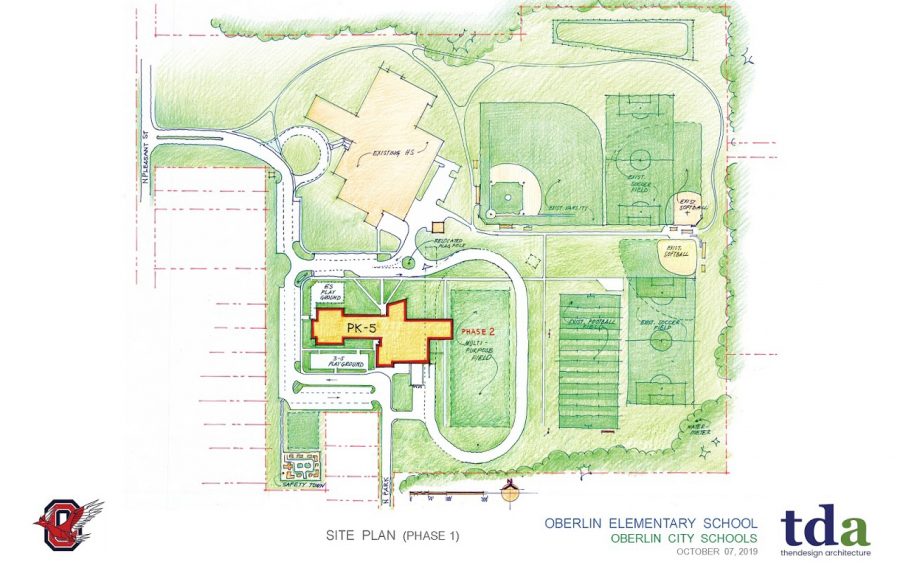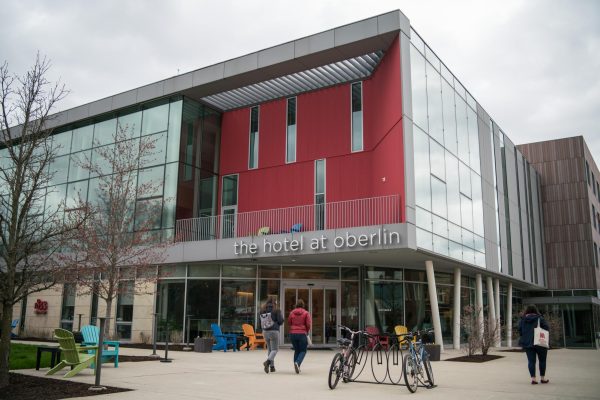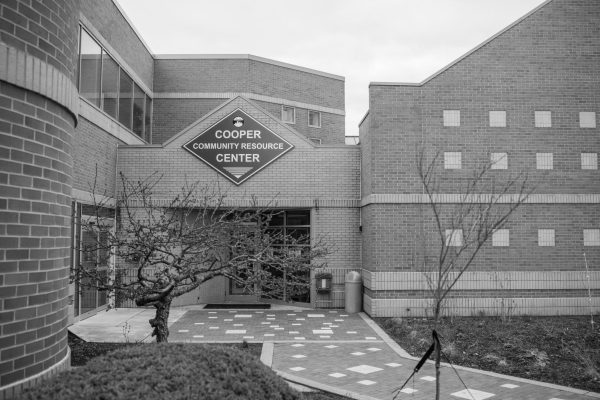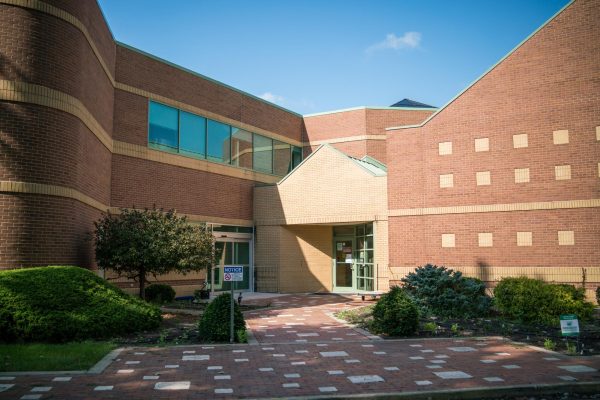School Construction Concerns Residents; District Maintains All Is Well
Photo courtesy of Oberlin City Schools
The site plan for a new school building on N Pleasant St. in Oberlin. The new building will consolidate Oberlin’s four public schools, creating a space for students PK–12.
As Phase I construction on Oberlin City Schools’ new combined school facility continues, district and school board leadership maintain that the project is proceeding on schedule and on budget, despite community concerns to the contrary. In particular, some residents have expressed unease about the demolition of Oberlin High School’s football field in order to make space for the new building.
In November 2018, voters approved a bond measure that would, over 37 years, generate $17.8 million to fund the construction of a new district building to put all PK–12 students under one roof. The construction was planned to take place in two phases: Phase I, currently ongoing, will create a PK–5 facility; the 6–12 space will be added to the facility later.
District leadership is largely pleased with the Phase I construction to this point.
“I think it’s going very well,” said Albert Borroni, OC ’85, Board of Education president and director of the Oberlin Center for Technologically Enhanced Learning. “We have, obviously, constraints on how much money we can spend. The architects and our staff in the district are working together to get the most out of that.”
For some community members, however, a perceived lack of communication on the part of the district has created frustration.
“They’re doing exactly what they always do,” said Sandra Redd, a former district parent who was active in opposing the 2018 bond measure. “They communicate when they think it’s necessary for you to know, and they’re only going to give you so much information. That’s what they always do, and what they don’t want you to know they don’t tell you.”
A particular point of concern among residents regards the placement of the school facility. When the bond issue was placed on the ballot, the district had not yet decided where the new building would go. After the bond issue passed, district leadership considered a number of locations before settling at the site of the current high school. This placement required the district to demolish the high school’s existing football field, a decision that has garnered resident opposition and left the high school’s team playing games at the College’s facilities.
Moving forward, it’s not clear how this development will be addressed.
“If we can negotiate with [the College] to figure out some way of sharing that space, at least for games, that would be the best approach,” Borroni said. “Others are leaning the other way saying we should put in our own football field. We’ll have to see when the second phase comes up, who’s on the board and how that plays out.”
Since the bond was approved, a number of other developments have also caused residents to worry that Phase I’s construction costs would be higher than expected. These include new tariffs imposed by the Trump administration on materials imported from China and a likely reduction in the amount of money that the district will receive from the NEXUS pipeline.
“The costs are a little higher than we were hoping for,” said Ken Stanley, a member of Oberlin’s school board. “I think quite a number of schools passed levies in 2018 … That meant there was a large demand for schools and a limited number of contractors can do it. That probably increased the cost. The tariffs on China definitely increased the costs for us.”
According to Stanley, the project’s funding streams are relatively straightforward.
“The district is paying 100 percent of the cost of Phase I, which is somewhere around $17 million, give or take,” Stanley said of the funds acquired through the 2018 bond issue. “The state will then reimburse us for 21 percent of the cost of that, subject to their constraints. They have rules about what they’ll fund and what they won’t fund.”
Examples of projects that the state won’t fund include auditoriums, football stadiums, and school board offices, according to Stanley. He also said that it’s not totally clear when the partial reimbursement from the state, which only applies to eligible projects, will arrive.
“The state doesn’t know when our number will come up,” Stanley said. “There’s still a lot of districts ahead of us, and more and more of them seem to be jumping in. Twenty years ago, the state told us we were five to seven years from getting funded, and they’re still telling us five to seven years.” He added that the state can only make guesses about which districts will submit funding requests, and that inaccurate estimates of funding timelines aren’t meant to mislead.
At some point, the district will also receive money in the form of property taxes from the NEXUS pipeline. However, it’s unclear exactly when that money will arrive and in what amount.
“That is not on the books yet,” Borroni said. “But we do anticipate [NEXUS money] to be there. It’s not necessarily earmarked for the building, but that’s where it’s going to end up.”
Borroni maintained that none of the Phase I costs were dependent on NEXUS money, but the fact that the district expects it raised concerns for some.
“They were counting on $1.7 million a year to come in from the NEXUS pipeline which was, excuse the pun, a pipe dream,” said City Council Member and district parent Kelley Singleton. “They were counting on that as a reality, and there was never any guarantee that that was going to happen.”
Currently, attorneys representing the pipeline’s owners are engaged in legal proceedings in the hopes of reducing the amount that will be paid to both the school district and the City itself. Crucially, those are two different amounts, and the school district will receive more as it encompasses more area than the city. According to a Dec. 18, 2019 article, NEXUS lawyers are seeking a 38 percent reduction of the amount impacted communities were initially set to receive, originally about $9.5 million (“NEXUS seeks to scale back pipeline revenue, Lorain County officials speak out against the move,” The Morning Journal).
Singleton also raised concerns that the amount raised in the initial bond measure may not be enough to fully cover construction costs, especially after the recent tariffs and other developments.
“Without seeing the numbers, I can’t imagine that it could be [proceeding on time and on budget], with the tariff situation and with the NEXUS money,” he said.
For his part, Oberlin City Schools Superintendent David Hall was vague about potential funding streams the district can access beyond the amount raised by the bond issue.
“NEXUS funding may be coming in and we do have some extra funds, whatever we may have,” Hall said, adding that the district will also be able to capitalize on recent financial prudence. “We did great the last four or five years here; we’ve been able to save money.”
Hall also maintained that the amount raised by the initial bond issue will be enough to cover all costs associated with Phase I construction — any additional funds from NEXUS or other sources would go toward what he called “enhancements.”
Stanley believes that, if the district plays its cards right, the construction of Phase II — the grade 6–12 addition — could be covered through existing funding streams. This would mean that the district would be able to complete construction of the entire PK–12 facility without raising taxes further.
“[One thing] we have done to try to give us our best shot at being able to fund Phase II with the same 4.8 mills is to move as much of our debt as possible … into the first 10 years,” Stanley said.
Stanley explained that, over the last two years, property taxes in Oberlin have increased by roughly 25 percent, largely due to NEXUS-related development. He hopes that, if a similar increase can be achieved over the next eight years, the 4.8 mills raised by the original bond measure will result in enough increased revenue to cover both phases of the new building.
Still, Redd is concerned that current taxes — which she already perceives as high — could increase further as construction continues and the district moves on to Phase II.
“I live in [New] Russia Township and they’re eating us for a piece of toast,” Redd said. “I mean, it’s just ridiculous out here. I have a lot of farmland, and it’s outrageous what we have to pay in taxes — and for what?”
The Phase I facility is expected to open for PK–5 students in fall 2021. Residents can find construction updates under the “District News” header on the homepage of the district’s website.






